Conference review
Two Nobel laureates and several highly successful scientists participated in the twenty-first Meeting of Nobel Laureates and Talented Students, held in December 2023 by the National Academy of Scientist Education. The students also had the opportunity to meet distinguished professors from Hungarian universities. The conference was attended by 235 students from 53 secondary schools.
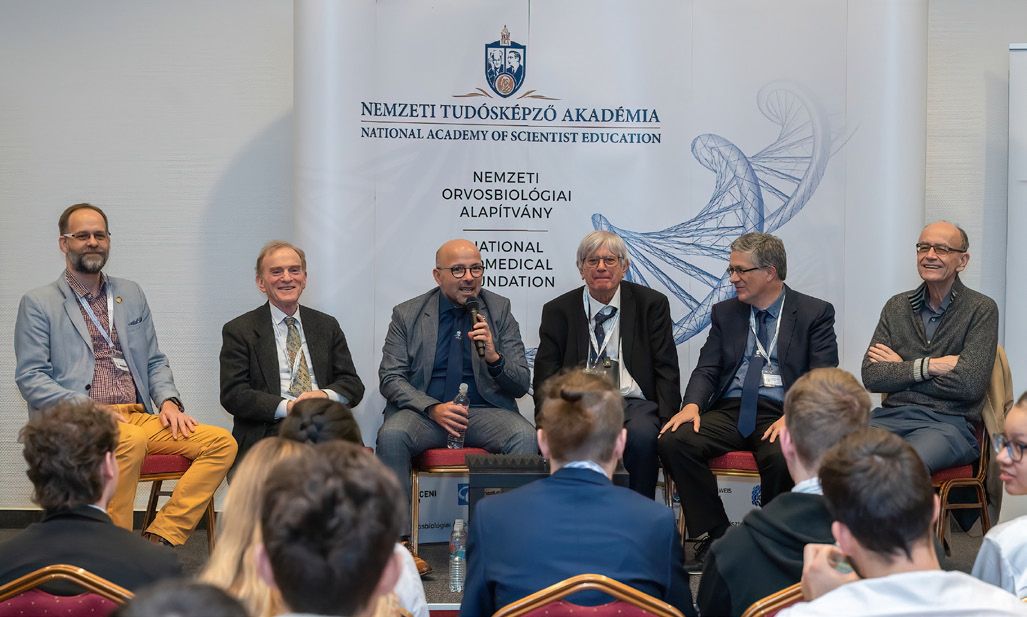
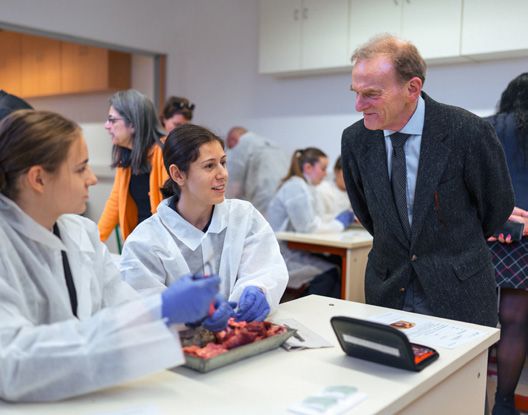
High school students took over the congress hall, lecture halls, and atrium of the University of Szeged’s Study and Information Centre during the two days of the National Academy of Scientist Education’s (NASE) Meeting of Nobel Laureates and Talented Students conference in December. More than two hundred students were waiting to meet the researchers, including the two Nobel laureate star guests. After the opening ceremony, and before the arrival of the guests of honor, the university students from the Szent-Györgyi program delivered presentations on their research in the congress hall. One of them, for example, investigated the consequences of oxygen deprivation in the retina, while another presented research on the activity and expression of a background calcium channel with an exceptional structure. In parallel with the lectures, another program was held, where high school and university Szent-Györgyi students could meet each other in round-table discussions. Presentations were also given by the mentors facilitating the program.
In the late afternoon, two guests of honor, Randy W. Schekman and Ole Petersen arrived to visit high schools in Szeged. Professor Schekman is an American biochemist and cell biologist who contributed to the discovery of the genetic basis of vesicle transport in cells. For his insight into the genetic mechanisms underlying vesicle transport, he was awarded the 2013 Nobel Prize for Physiology or Medicine, which he shared with James E. Rothman and Thomas C. Südhof. The other researcher who visited the two high schools was Ole Holger Petersen, a Danish physician and physiologist who is currently a professor at Cardiff University. He was the very first in the world to use the patch clamp technique on epithelial cells. Ole Petersen got the Palade Prize in 2022. This prize is the most distinguished award for excellence in pancreatic research particularly for deciphering basic mechanisms of pancreatic physiology, and the disease pathophysiology. Professor Petersen is the former Vice-President of the Academy of Europe, and he was one of the founding members of that in 1988.
VISITING HIGH SCHOOLS
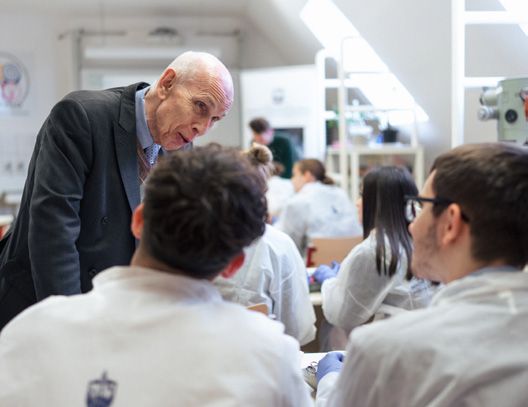 The two scientists first visited the laboratory of the SZTE Primary and Secondary Grammar School, where the children dissected pig hearts in a hands-on exercise. “This meeting is a great honor for us, and Randy Schekman is not the first, but the fifth Nobel Prize winner to visit our laboratory. They have all been very kind and attentive, talking to students well beyond protocol time. This is inspiring for children and colleagues alike, a special occasion for all of us. Right now, cellular, molecular-level research is the most important, but as most of the students are training to be doctors or research physicians, they also need to know anatomy. Dissecting pig hearts gives an insight into this,” said István Csigér, the school’s biology and chemistry teacher. The two researchers got an insight into the students’ work by going to their desks and talking to them directly. Later Professor Schekman addressed a talk to the class as a whole. “If you enjoy this kind of challenge, then research is something that you might do as well. In this school, you have the opportunity to do individual science projects. I think that’s something that would be good for your school and other schools to offer you the opportunity to do an individual project of your own time with perhaps some advisor, a teacher who advises you, but you make decisions about what to do. And that’s the challenge,” said the professor. At the end of the visit, the children could ask questions from not only the Nobel Prize-winning researcher, but also from his wife, who is also a scientist. Sabeeha Merchant is a Professor of Plant and Microbial Biology, Biochemistry, Biophysics, and Structural Biology at the Department of Molecular and Cell Biology at UC Berkeley. Among other things, the students wanted to know what the researcher thought about the position of women in science. She said that the situation has improved in the last few decades, but there were clearly lower expectations for women in the past, which is not a good thing, because a woman can perform just as well as a man. “Now it’s not nearly the problem that it was. More women are advancing and taking the opportunity to be an independent player,” said Professor Merchant.
The two scientists first visited the laboratory of the SZTE Primary and Secondary Grammar School, where the children dissected pig hearts in a hands-on exercise. “This meeting is a great honor for us, and Randy Schekman is not the first, but the fifth Nobel Prize winner to visit our laboratory. They have all been very kind and attentive, talking to students well beyond protocol time. This is inspiring for children and colleagues alike, a special occasion for all of us. Right now, cellular, molecular-level research is the most important, but as most of the students are training to be doctors or research physicians, they also need to know anatomy. Dissecting pig hearts gives an insight into this,” said István Csigér, the school’s biology and chemistry teacher. The two researchers got an insight into the students’ work by going to their desks and talking to them directly. Later Professor Schekman addressed a talk to the class as a whole. “If you enjoy this kind of challenge, then research is something that you might do as well. In this school, you have the opportunity to do individual science projects. I think that’s something that would be good for your school and other schools to offer you the opportunity to do an individual project of your own time with perhaps some advisor, a teacher who advises you, but you make decisions about what to do. And that’s the challenge,” said the professor. At the end of the visit, the children could ask questions from not only the Nobel Prize-winning researcher, but also from his wife, who is also a scientist. Sabeeha Merchant is a Professor of Plant and Microbial Biology, Biochemistry, Biophysics, and Structural Biology at the Department of Molecular and Cell Biology at UC Berkeley. Among other things, the students wanted to know what the researcher thought about the position of women in science. She said that the situation has improved in the last few decades, but there were clearly lower expectations for women in the past, which is not a good thing, because a woman can perform just as well as a man. “Now it’s not nearly the problem that it was. More women are advancing and taking the opportunity to be an independent player,” said Professor Merchant.
The researchers’ next stop was the Radnóti Miklós Experimental Grammar School in Szeged. Sándor Bán, the school’s biology teacher, gave the scientists an insight into the work going on there, and later accompanied them to the laboratory, where they met the students. “We did a quantification. In this exercise, we had to determine the protein content of samples by spectrophotometry. We used the Bradford reagent, which forms a blue complex with the proteins in about 30 minutes, which can be measured spectrophotometrically. Professor Randy Schekman came to our table, and it was very interesting to notice that when he started to speak, he radiated indescribable energy. He asked tough questions, he pointed out connections. It was very inspiring to talk to a Nobel laureate,” says Csongor Darvasi, a biology student of the school. Principal Anett Nagy highlighted that the children were motivated by the conference, it was very interesting for them to glimpse into the world they would like to be a part of. “During the visits, the students can learn about the researchers’ experiences and get advice from them, and from the discussions they can draw strength for their career choices,” said the principal.
MEET THE GREATEST RESEARCHERS
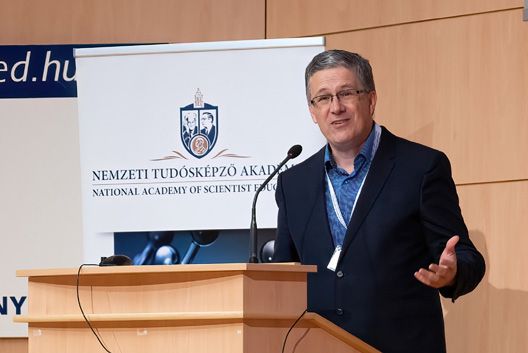 The afternoon program of the conference started with a plenary session, opened by Professor András Varró, strategic director of NASE, and Professor Péter Hegyi, program director of NASE. Professor Hegyi delivered a special presentation on the program of the National Academy of Scientist Education, while Professor Zoltán Rakonczay, Director of University Education, gave a presentation on the Academy’s University Education program. After that, the first speaker was Professor Miklós Sahin-Tóth, one of the guests of honor. He is a world-renowned expert in the area of pancreatic disorders with a focus on genetic risk factors in chronic pancreatitis. He is a professor at UCLA, and studies combined biochemical, cell biological and animal model approaches with data obtained from human genetic association studies. He aims to formulate molecular disease models that explain genetic susceptibility to chronic pancreatitis. The second speaker was Professor Randy Schekman, who gave a talk on genes, cells, and discovery in basic science. He was followed by Professor Ole Petersen, who gave a presentation titled The scientific process: how do we get it right. The next speaker was Professor Thomas Südhof, a German American neuroscientist, whose findings helped scientists to understand the cellular mechanisms underlying neurological conditions such as autism, schizophrenia, and Alzheimer’s disease. For his breakthroughs, Professor Südhof was awarded the 2013 Nobel Prize for Physiology or Medicine, which he shared with James E. Rothman and Randy W. Schekman.
The afternoon program of the conference started with a plenary session, opened by Professor András Varró, strategic director of NASE, and Professor Péter Hegyi, program director of NASE. Professor Hegyi delivered a special presentation on the program of the National Academy of Scientist Education, while Professor Zoltán Rakonczay, Director of University Education, gave a presentation on the Academy’s University Education program. After that, the first speaker was Professor Miklós Sahin-Tóth, one of the guests of honor. He is a world-renowned expert in the area of pancreatic disorders with a focus on genetic risk factors in chronic pancreatitis. He is a professor at UCLA, and studies combined biochemical, cell biological and animal model approaches with data obtained from human genetic association studies. He aims to formulate molecular disease models that explain genetic susceptibility to chronic pancreatitis. The second speaker was Professor Randy Schekman, who gave a talk on genes, cells, and discovery in basic science. He was followed by Professor Ole Petersen, who gave a presentation titled The scientific process: how do we get it right. The next speaker was Professor Thomas Südhof, a German American neuroscientist, whose findings helped scientists to understand the cellular mechanisms underlying neurological conditions such as autism, schizophrenia, and Alzheimer’s disease. For his breakthroughs, Professor Südhof was awarded the 2013 Nobel Prize for Physiology or Medicine, which he shared with James E. Rothman and Randy W. Schekman.
The Friday program of the conference started with a private meeting of university Szent-Györgyi students and guests of honor. Randy Schekman, Thomas Südhof, Miklós Sahin-Tóth, Zoltán Rakonczay, András Varró, and Péter Hegyi took the podium, but it was an informal discussion, and students were free to ask the participants anything they were curious of. Later, high school students could talk in small groups for more than an hour with some of the greatest scientists of their fields. The students sat around 23 round tables in the atrium of the Study and Information Centre, in groups of 9-11. Some tables were chaired by Randy Schekman and others by Thomas Südhof. Sheeha Sabanali Merchant was also a panelist, as were Ole Petersen and Miklós Sahin-Tóth. Highly respected researchers from Hungarian universities also took part in the program, for example, Péter Hegyi, Éva Kondorosi, Lajos Kemény, Attila Mócsai, Zoltán Rakonczay, and Balázs Hangya. Talking to the researchers and hearing their personal stories can help young people learn about the challenges of a science career, and the various paths to success. They might understand why it is worthwhile to start a research career. After the round-table discussions, students were also given the opportunity to visit the laboratories of the Szent-Györgyi mentors on a pre-scheduled basis.
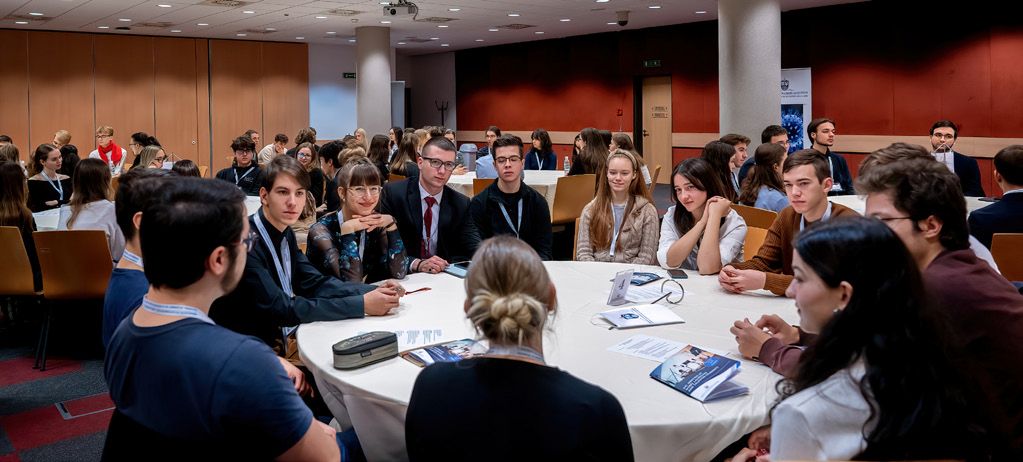
TEN YEARS OF SCIENTIFIC TRAINING HAVE PAID OFF
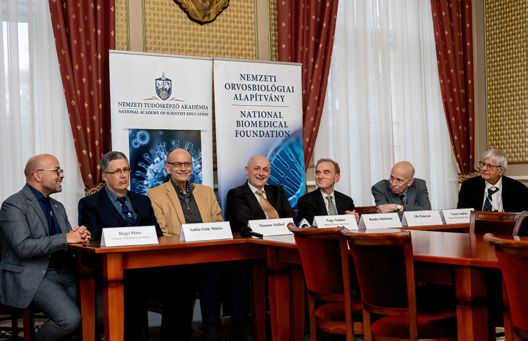 The 21st Meeting of Nobel Laureates and Talented Students was closed with a press conference at the Town Hall. The event was attended by Randy Schekman, Thomas Südhof, Miklós Sahin-Tóth, András Varró, Péter Hegyi and Ole Petersen, as well as Deputy Mayor for Urban Development Sándor Nagy. “Once again we have the honor of welcoming Nobel laureates to the city. I’m almost getting used to sitting between Nobel Prize winners at the table. The city of Szeged had been supporting the Academy of Scientist Education from the very beginning, its predecessor having been established ten years ago as the Szeged Academy of Sciences. Our city has long been a national center of education and science, where training in life sciences is outstanding,” said Sándor Nagy, who opened the press conference. Péter Hegyi took the floor from him. “At our conference six major research institutions, including colleges and universities, represented themselves from all over Hungary. And until now, 14 Nobel laureates and around the same number of distinguished high-profile researchers were here to show a role model for students,” said Professor Hegyi. Professor Petersen, who has been familiar with the program for years, also shared his thoughts on the program. “I came for the first time to visit this program in 2019. I obviously didn’t know what to expect. But now I am amazed at the quality of the students here. We had really very nice conversations. The students asked an enormous number of questions, but they were really relevant questions. So that was a nice experience,” said Professor Petersen.
The 21st Meeting of Nobel Laureates and Talented Students was closed with a press conference at the Town Hall. The event was attended by Randy Schekman, Thomas Südhof, Miklós Sahin-Tóth, András Varró, Péter Hegyi and Ole Petersen, as well as Deputy Mayor for Urban Development Sándor Nagy. “Once again we have the honor of welcoming Nobel laureates to the city. I’m almost getting used to sitting between Nobel Prize winners at the table. The city of Szeged had been supporting the Academy of Scientist Education from the very beginning, its predecessor having been established ten years ago as the Szeged Academy of Sciences. Our city has long been a national center of education and science, where training in life sciences is outstanding,” said Sándor Nagy, who opened the press conference. Péter Hegyi took the floor from him. “At our conference six major research institutions, including colleges and universities, represented themselves from all over Hungary. And until now, 14 Nobel laureates and around the same number of distinguished high-profile researchers were here to show a role model for students,” said Professor Hegyi. Professor Petersen, who has been familiar with the program for years, also shared his thoughts on the program. “I came for the first time to visit this program in 2019. I obviously didn’t know what to expect. But now I am amazed at the quality of the students here. We had really very nice conversations. The students asked an enormous number of questions, but they were really relevant questions. So that was a nice experience,” said Professor Petersen.
At the press conference, Professor Randy Schekman highlighted that the National Academy of Scientist Education, which he had the opportunity to meet over the past few days, is impressive in bringing together the best students and the best biology teachers, and connecting students with Hungarian universities and foreign researchers. “I’ve never seen anything like this anywhere else. I wish I had an opportunity like that when I was young, it’s a fantastic opportunity for promising students. I think that organizing it at an even higher level could bring the enthusiasm that young people have to your legislators, so your government officials will be aware of the opportunity that they have – but they may lose it, by not investing in universities all over the country to provide opportunities for exploring the universe. Good luck!” says the scientist. Professor Südhof also gave his thoughts on the program.
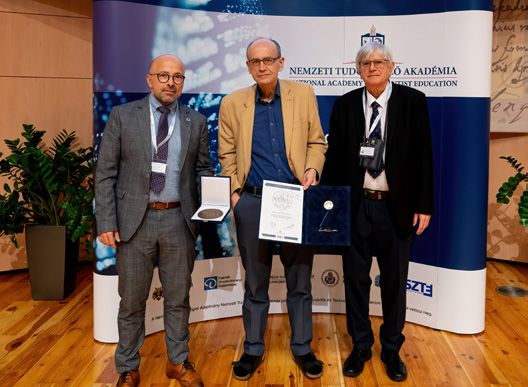 “I have only been here for a day, but just like Randy, I was impressed by the meeting, and by all the young people, and my interactions with them. I think in all countries it’s a challenge for young people to go into science and make a living and have a career that is attractive to them. I think it’s really important to increase the level of support, not only for science, but also for the careers of scientists at all levels,” said the Nobel-winning scientist.
“I have only been here for a day, but just like Randy, I was impressed by the meeting, and by all the young people, and my interactions with them. I think in all countries it’s a challenge for young people to go into science and make a living and have a career that is attractive to them. I think it’s really important to increase the level of support, not only for science, but also for the careers of scientists at all levels,” said the Nobel-winning scientist.
The press conference was also addressed by Professor Sahin-Tóth, who said that the program was spectacular this year. “What we are really waiting for is the final stage to see how many of these students will become real scientists. The ultimate goal for some of them is to become Nobel laureates. But I couldn’t agree more with Randy that to develop this program further, we need high level support and we need continuous support from the government”, said Professor Sahin-Tóth. The press conference was closed by Professor András Varró, who played a key role in the launch of the Academy. “Thank you for all of you coming here. We appreciate it very much, and I would like to express my take on behalf of our society, on behalf of all of Hungary, because this program is very important to us. I would also like to thank the government. This program and this conference would not have been possible without the significant support of the government, the city of Szeged, and also Hódmezővásárhely, and many other cities that were involved. There were excellent scientific talks, but I think the major contribution was to deal with the students and try to keep their enthusiasm, to prove that science could be a successful profession in Hungary, and so the country will have its future scientists.”
Emese Szabó
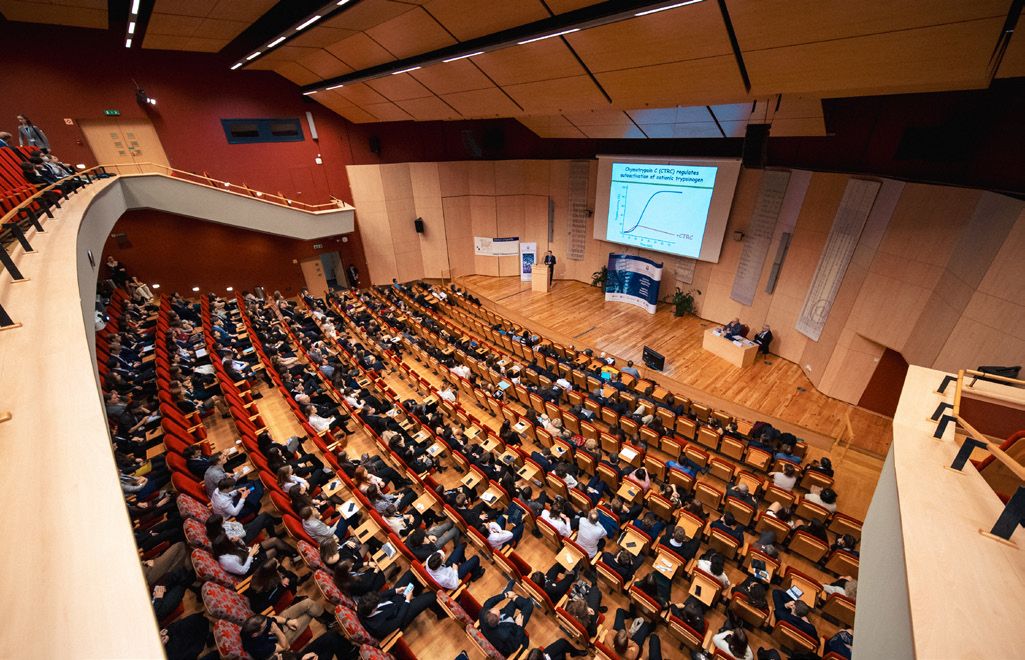
2024.01.19.
Back